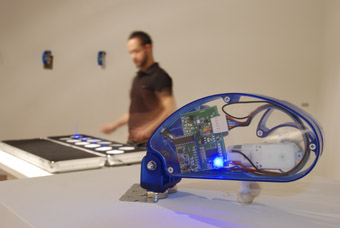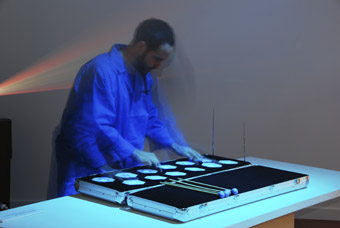artful infestation
christian mccrae: matthew gardiner’s radiobots

Eugene Ughetti and Radiobot
photo Matthew Gardiner
Eugene Ughetti and Radiobot
“WAS THAT THING FROM PREDATOR?” TWO SHEPPARTON TEENAGERS AMBLING AWAY FROM MATTHEW GARDINER’S NEW SHOW RADIOBOTS WOULD MISTAKE THE WORK’S CENTRAL INTERACTIVE CONSOLE, WITH A SERIES OF SEQUENTIAL INSIGNIAS, AS BASED ON THE EXPLOSIVE DEVICE ON THE ARM OF THE 1980S ACTION FILM’S ALIEN. OF THE WEIRD CONNECTIONS ONE CAN MAKE WHILE OPERATING RADIOBOTS, IT MAY NOT BE SO INCONGRUOUS TO ASSUME OF THEM AN OTHERWORLDLY ORIGIN.
The work is presented as a contraption in the truest sense; a short slideshow loop plays on a screen across the gallery, detailing the design and construction process. The Rabiobots themselves are meticulously constructed objects, looking somewhat like products of a marriage between a stapler and a cockroach. Inside their blue carapace, radio receivers are connected to a simple mechanism that makes them loudly tap a sinister pair of proboscises against the surface to which they are attached. Inside the front rooms of the Shepparton Art Gallery, they are affixed to plinths of various heights, to walls, to ceilings. One, most satisfyingly, is on a strip of metal, looking all the world like a caterpillar with a leaf to itself. To signal each of them to act, visitors approach the console and tap on hexagonal plastic drum pads.
While surly teenagers and roaring children are happy to experiment with hardcore death metal speed-drumming and group concertos, the noise that the contraption produces with a single tap is just as vital. Percussive art practices have often found silence as pliant and malleable as clay. Yet the quietude of the Shepparton Art Gallery, apart from anything else, is manifestly different, not the least reason being the phantasmagorical surprise of the Radiobots’ clack-clack when you are elsewhere in the gallery. The sonic force reverberates around the rooms and halls to symbiotic effect—what seems like an infestation of the alien quickly becomes a polyvocal chorus of the environment. The gallery grows itself a tongue with which to clack.
Gardiner recapitulated this impulse by performing a series of Radiobots workshops and performances with collaborators, percussionist Eugene Ughetti and Aphids’ director David Young. With a residency with Ars Electronica in Austria, Gardiner has positioned this generation of Radiobots as a nursery for future percussive installations internationally while attenuating the exhibit to the local environment. His work has concentrated on hybrid practices for many years; the Oribotics sequence from 2004-2008 also invoked a range of concerns to do with local environments and the swarming memories of people interfacing with his artworks. Shepparton, then, demands that it uses the gallery’s tongue as well. 
Eugene Ughetti, Radiobots
photo Matthew Gardiner
Eugene Ughetti, Radiobots
With a diverse range of gallery programs growing and changing in the vast Australia outside the capital cities, it becomes harder to dismiss regional galleries as provincial. Shepparton’s upstairs pottery collection, was one of the best places to experience Gardiner’s installation. Through the peculiarities of sonic accrual, it was possible to sense the Radiobots sending a disturbance in the air, and in the vibrations coming up through the ground, it was like listening to sealife converse underneath a sheet of ice. There, generations of handicrafts posed for ornament and historicity emanated slight hollow echoes each time a pad downstairs was pushed. Just a few feet away, Rita Lazauskas’s melancholic daily sketches and drawings were similarly altered, as the distinction between the heaviness of her images from home and the lightness of those made during travel were punctuated and made more pronounced by the aural hammering.
A quick visitor to the gallery, however, might see a more inchoate and disconnected form of life, perhaps parasitic in the best tradition rather than romantically symbiotic or expressive. The work is, despite the cool and clinical construction, also an agent of purest bedlam. The percussive effects swarm around the rooms as the pads are struck in sequence, while the work is arranged in such a way that they likewise fold behind the front desk and its staff, who also become agents in this unusual biosphere.
All sound art is also about the spaces and volumes in which the sound lives. In a sense, the teenagers were right, the Radiobots are predatory after all. If you do not stay to inhabit the space yourself, the work dominates. The future installations and generations of Radiobots promise Ars Electronica in Linz as a site of infestation, alongside bridges and public objects—more localities in which to grow tongues, and new audiences to speak in them.
Radiobots, artist Matthew Gardiner, ?technical designer Ray Gardiner?, composer David Young, ?percussionist Eugene Ughetti?, producer Aphids in association with Shepparton Art Gallery and Riverlink, Shepparton Art Gallery, Victoria, Sept 1-20
RealTime issue #93 Oct-Nov 2009 pg. 32






